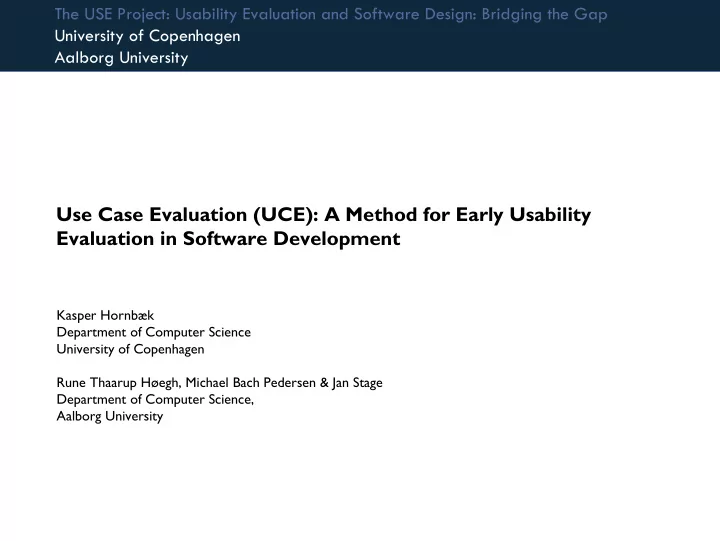

The USE Project: Usability Evaluation and Software Design: Bridging the Gap University of Copenhagen Aalborg University Use Case Evaluation (UCE): A Method for Early Usability Evaluation in Software Development Kasper Hornbæk Department of Computer Science University of Copenhagen Rune Thaarup Høegh, Michael Bach Pedersen & Jan Stage Department of Computer Science, Aalborg University
Aim and Motivation • Use Case Evaluation (UCE): Usability evaluation based on use cases • Usability problems are cheaper to solve early in the development process • Identifying usability problems early in the process is difficult with the current software development practice • Usability work is usually separated from core software development activities • Most usability work takes place late in the software development process • Use cases • Available early in the development process • Already part of many development methods • Valuable means for integrating usability in the software development process The USE Project: Usability Evaluation and Software Design: Bridging the Gap 2
Use Case Evaluation (UCE) Inspection of Use Cases Use cases Guidelines Documentation of Evaluation Assessment of Use Cases Evaluation products • Fully dressed use cases (Cockburn) are recommended • List of guidelines assist the inspection (11) • Based on heuristics from Heuristic Evaluation (9) • Supplemented with guidelines from other methods (2) • Evaluation product • Assessment of the usability of the system; a list of usability problems • Assessment of the quality of the use cases The USE Project: Usability Evaluation and Software Design: Bridging the Gap 3
Usability Problem • Definition: ”An aspect of the system that will hinder or delay the user in completing a task, be difficult or impossible for the user to understand, or cause the user to be frustrated”. The USE Project: Usability Evaluation and Software Design: Bridging the Gap 4
Example of Fully Dressed Use Case (partial) The USE Project: Usability Evaluation and Software Design: Bridging the Gap 5
Procedure for Inspection of Use Cases • One or more evaluators • Brainstorm • Use cases inspected one by one • Note problems that may be predicted • Systematic inspection based on 11 predefined guidelines • Use cases inspected one by one • Note problems that may predicted while employing the guidelines • Where may a guideline be breached? • Fruitful to go over all use cases at least twice • Asses the overall quality of each of the use cases • If more than one evaluator • Create a joint problem list The USE Project: Usability Evaluation and Software Design: Bridging the Gap 6
Guidelines for Use Case Evaluation The USE Project: Usability Evaluation and Software Design: Bridging the Gap 7
Empirical Study I • 4 evaluators with 2-8 years of experience in HCI after obtaining masters degree • Health care application (HealthMonitor) • Monitors elderly persons’ medical conditions in their home • Four fully dressed use cases was described for the HealthMonitor • Avg. 472 words long and consisted 6-19 steps • Evaluators received descriptions of • The experimental procedure to be followed • The UCE method • The four use cases • An explanation of the HealthMonitor’s general use context The USE Project: Usability Evaluation and Software Design: Bridging the Gap 8
Empirical Study II • Usability problems reported by • Title • Place(s) where found • Related use case • Guideline breached • Severity rating (cosmetic, serious or critical) • Matching of problems into a joint problem list • General assessment of the use cases • Evaluators opinions on using the UCE method • Comparison with think-aloud usability evaluation of the HealthMonitor • Five user sessions • Analysed by Instant Data Analysis (IDA) • Analysed by conventional video based analysis The USE Project: Usability Evaluation and Software Design: Bridging the Gap 9
Results I The USE Project: Usability Evaluation and Software Design: Bridging the Gap 10
Results II The USE Project: Usability Evaluation and Software Design: Bridging the Gap 11
Discussion • Large portion of usability problems identified through both UCE and conventional method • Several other usability problems were assessed as being useful • Additional benefits from inspection based on use cases • Early focus on usability issues in a natural way • May uncover and emphasize non-functional requirements • May improve overall quality of the use cases • Still need to be empirically documented • Potential improvements on UCE: • Style of writing use cases • Used guidelines • Inspection across use cases for inconsistencies The USE Project: Usability Evaluation and Software Design: Bridging the Gap 12
Limitations & Further Work • Did not assess impact of UCE evaluation in a real-life context • Not a strict experiment • Participants not randomly assigned to think-aloud or UCE • Partly conducted by authors who also had developed the method • Follow-up study by other researchers necessary • Possibly with non-expert participants • Despite the limitations • Our paper suggest that inspection of use cases may help introduce effective usability evaluation early in the software development process The USE Project: Usability Evaluation and Software Design: Bridging the Gap 13
Questions? The USE Project: Usability Evaluation and Software Design: Bridging the Gap 14
Recommend
More recommend